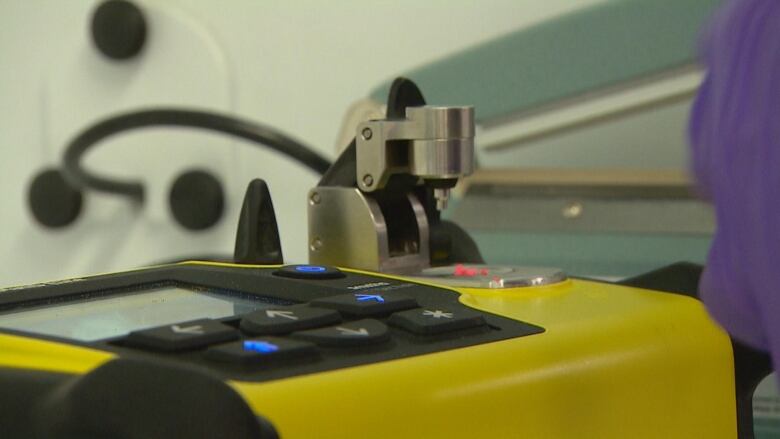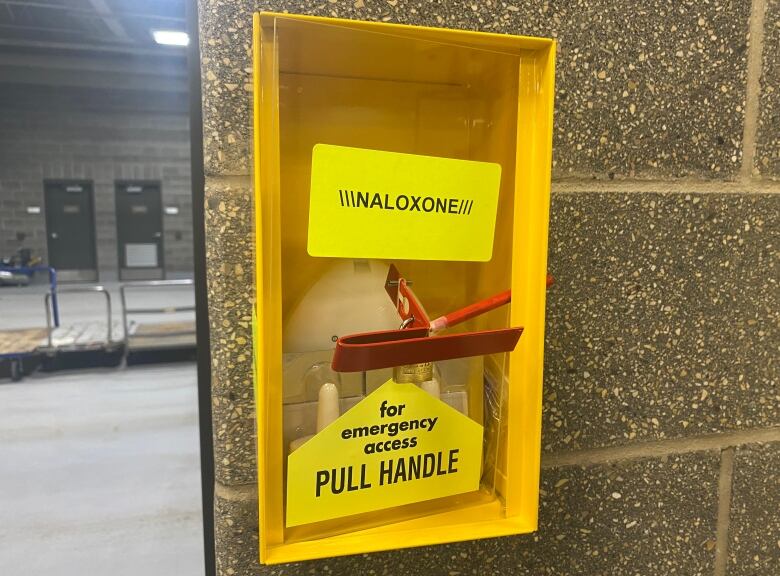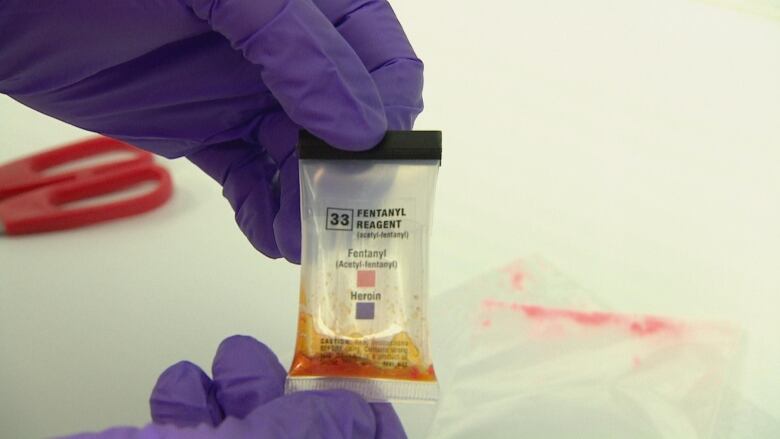What's inside the drugs circulating Calgary? We visited the city police testing lab to find out
Popular drugs cut with a number of potent and unpredictable substances
This story is part of a series called The Way Out: Addiction in Alberta.Join the discussion, or read more about the serieshere.

At the Calgary Police Service headquarters inthe city's northeast, there is a sprawling compound of interconnected buildings.
Inside one of those buildings is what's called the evidence and property room. It's where police keep anything they've seized, especially drugs.
Sprawled out in front of an undercover officer are small baggies of fentanyl, cocaine and methamphetamine the most popular drugs circulating in Calgary right now.
But for anyone buying them, it's not all they're ingesting.
"So you see here what's in it," said Terry, who works with the drug unit. CBC News is not using his real name as it would impact his work.
He's just scooped some cocaine onto a drug testing machine that can detect approximately 10,000 different elements.

"Diethylene. Bromo-tetramethyl. That's going to be a [benzodiazepine] there and sodium nitrate. And it tells you a little bit what it is.The sodium nitrate can be a precursor to an explosive."
That's not all he finds. As the day goes on, there are fertilizer agents, colouring agents and products used in industrial and farming processes.
There is another powerful drug creeping into the illicit drug supply that users are being warned about. It's calledxylazine and it's used to sedate horses and cattle.
- Animal tranquilizer showing up in human overdose deaths
- Why is Canada's illicit drug supply so deadly and what's being done about it?
Dealers use cheapersubstances to cut, or dilute, popular drugs, stretching their supply to createmore profit.
Staff Sgt. Kyle Grant, who works with the CPS undercover unit, says it's a recipe for a moreunpredictable andpotent drug supply.
"Some of the cutting agents that are put in there are not, they're not fit for human consumption," he said.
"Drugs are made not to a pharmaceutical grade, and so everybody reacts differently to them."

For the past two years in Alberta, at least four people a day, on average, have died from overdosing on illicit drugs, according to provincial statistics.
And the drugs aren't hard to access. It's about five dollars for what's considered one hit of fentanyl or meth.
But without a test, you can't be sure what you're getting. And overdoses happen fast.
Unpredictable supply
Chelsea Burnham knows about this first hand. She was a drug user and now considers herself in recovery.
She remembers one of the times she overdosed. She was being transported in an ambulance from a supervised consumption site, which is a space where people can bring their own drugs to use in front of trained staff.
"They're like, 'You're having an opiate overdose, but you also seem to be having a barbiturate overdose,'" she said.
"I've never done a barbiturate in my life that I know of."
WATCH | Chelsea Burnham describes how she found her way out of addiction:
Grant says benzodiazepines, or "benzos," as they're called, are also commonly being used to cut drugs. They don't react as well to naloxone, which is a medication used to help reverse the effects of an overdose.
- New drug mix causing harder-to-revive overdoses, sparking panic in Vancouver
- Benzodiazepines found in 55 fatal overdoses in July as contamination mounts in B.C.
Burnham has heard of it happening.
"It's very scary and we've lost a lot of folks, sadly, to this benzo dope, they call it."

On top of the unpredictability of the drug supply, there's also concern about how the drugs are made.
Toxic hot spots
Back at police headquarters, Terry scoops another sample of fentanyl 100 times more potent than morphine putting it into a testing packet.
The drug looks like pink powder. Dealers use colour as a sales tactic, he explains, to differentiate between products.
"So that's going to be a colouring agent brown, and then your nitric acid and your ammonium bicarbonate," he said.
Two tests later, he still doesn't find a trace of fentanyl.

That's because one dose of fentanyl can be the size of a grain of sand, and unless it's picked up in that particular scoop, the sample will test negative.
These drugs are being made in someone's basement with no quality control, Grant says, so the ingredients can be unevenly distributed throughout a pill or powder.
Grant uses the example of a fentanyl tablet, which somepeople will split into quarters, taking one at a time.
"So they'll take a quarter, and after a while they're not feeling anything, so they'll take another quarter. Maybe nothing. And take another one," he said.
"Maybe in that one, all of the fentanyl has gravitated to that one area, which is called a hot spot. And because it's not evenly distributed, it's too much for your system and they overdose."
How do you respond?
As usual, there are varying responses to the problem of an increasingly toxic drug supply.
In B.C., the Centre for Disease Control now uses the terminology "unregulated drug poisoning emergency." And some drug users are being offered pharmaceutical grade drugs or safe supply to avoid the dangers of street drugs.
A womaninterviewed for this series, who we're calling "Jane," agrees with that approach. She works with people who use drugs and has had patients die because they have overdosed on drugs that were not what they thought they'd be.
We are not naming her because she worries criticizing the province's approach to the drug crisis might result in her losingher job.
"We need to treat a poisoning crisis. We cannot address it with treatment beds. We need to replace it with regulated drugs. We need to widely make regulated drugs available so people cannot use poison."

In Alberta, there's a very different approach. The province has said it will not allow safe supply, and Grant says he supports that.
"I think finding other ways to help addicts rather than giving them a drug or another drug is only beneficial," the staff sergeant said.
"I'm not a medical professional, but if you continue to give somebody drugs, you're still going to end up with the same problems down the line. I think you're just delaying the inevitable."
With files from Carla Turner














_(720p).jpg)


 OFFICIAL HD MUSIC VIDEO.jpg)
.jpg)



























































































